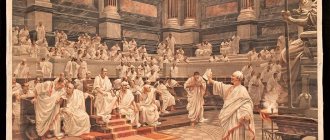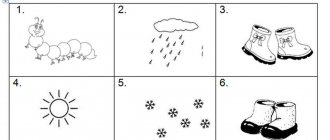Speaker's image . Part 1. Basic recommendations
What should a person look like in order to inspire trust among listeners literally from the first minutes?
In this article we will talk about how important the appearance of a person speaking in front of an audience is.
Read and apply these simple but very effective recommendations.
So. Everything in each of us should be harmonious. Therefore, both the internal state and the external appearance are always connected and people intuitively understand this. It is impossible to deceive your listeners if the main attention of the speaker is focused on “What do I look like?”
But neglecting your own appearance will also play a negative role. Many times in my life, at presentations held by sometimes even world-famous companies, I observed how the inappropriate image of the speaker simply destroyed all his words.
A proper appearance and image of a speaker can work wonders. It is not for nothing that the profession of image maker has developed so much.
Although you should never get hung up on appearance and consider it the main thing. Without a person’s internal work on himself to cleanse the soul, no external attributes will hide a tense face, insincere eyes and a harsh facial expression.
Clothes are only part of the overall harmony of a person, a person who respects himself.
People form their opinion of you within the first few seconds, just by looking at you, even before the speaker opens his mouth. In the first 2 minutes, people evaluate a person on more than 70 parameters.
Clothes say a lot, and first of all, about what you think about yourself, how well-mannered, educated you are and what you aspire to. With an attractive and appropriate appearance, you can win over the audience to your side even before the first word, or push them away if the appearance is inappropriate.
You set the tone for the entire coming day in the morning, when choosing clothes from your wardrobe.
You are the face of your company. People do not have the opportunity to see the central office or huge factories of the company, but you - yes, representatives of this company (it is not for nothing that many companies introduce uniforms).
RULE ONE
The appearance should be appropriate to the situation: place, topic and audience.
If you are giving a scientific report at your research institute, where every day your colleagues see you with a curly beard, a plaid shirt and soft comfortable loafers, they will be strange to see you clean-shaven, in a sharp suit, a crisp white shirt and black dress shoes.
If you have been invited to receive the Nobel Prize, then it is quite logical that, when delivering your acceptance speech, you will be dressed in accordance with the official dress code of the ceremony.
For different topics of speech, there is a different dress code for the speaker.
In order not to get confused, you need to easily remember two options: a strict and a democratic dress code.
The strictest dress code for conferences related to health and money. This is a dark suit, a plain light shirt, a tie for men, modest accessories for women and classic shoes.
In the creative, IT sphere, or if the event is held outside the city, you can look more democratic: jeans, a shirt, a pullover or jacket, comfortable shoes, for women - a dress, straight-fit trousers.
The development of oratory and the image of an orator in Russia at the present stage
Nowadays, rally and parliamentary eloquence is rapidly developing, which reflects the clash of various judgments, the struggle of opinions. In recent years, private rhetoric has also been developing, on the basis of which it is possible to improve speech communication in the so-called “areas of increased speech responsibility” (such as diplomacy and medicine, pedagogy and jurisprudence, administrative and organizational activities, social assistance, journalism, trade, services, etc. .).
S. F. Ivanova in her work “Specificities of Public Speech” [71] identified individual speech types of speakers
:
Rational - logical
. Speakers of this type are prone to analysis of phenomena, to reasoning and strict argumentation of their and other people's actions. Their preparation for any statement is characterized by consistent selection and strict systematization of materials, reflection and development of a detailed plan. This mature plan seems to “sit inside them,” and speakers do not use it during their speech. They are often concerned about something else: how to make their speech more vivid, emotional, what examples to choose to interest the audience. “Logicians” are most often sanguine people.
Emotionally - intuitive
. Representatives of this type speak passionately, enthusiastically, peppering their speech with witticisms and puns, but they cannot always follow the strict logical sequence of speech and “make ends meet.” A plan for their performances is not always written, considering that it constrains them. There is a coincidence of the emotional speech type with the choleric temperament.
For this type of speaker, the main thing, obviously, is to captivate the audience: he flies into the audience like a whirlwind, literally from the threshold. Gesturing energetically (according to A. Pease [158] - a sign of excessive emotionality or lack of self-confidence), he figuratively tells how important the subject of his presentation is for us. He is impeccably dressed, his knowledge is enormous (which delights some listeners, irritates others, and still others perceive him ironically), he cites interesting and truly new facts. The expression is so great that his gaze “darts” around the audience, his facial expressions express intense passion and emotion. It is customary to say about such lecturers that they found themselves in words. Their desire to convey information cannot be compared with distracting techniques - sudden movements, harsh intonation. It does not capture the audience, its emotional state is not conveyed to the listeners. The speaker does not think about the desires or interests of the audience and, with all the expressiveness of his speech style, he seems never to be heard. He reserved the right to “not see” the listener, lost objective consideration of tempo, intonation, and volume of speech; gestures were often unmotivated. And the excited speech itself turns out to be only a form of a specific “rhetorical attack”, which does not give the audience the opportunity to somehow express their attitude towards the speaker or ask a question. That is why, as a teacher, you should never use all available rhetorical reserves at the same time.
Philosophical.
Speakers - “philosophers” are more or less emotional, prone to analysis, sometimes they are very organized in their work, and sometimes without any visible organization they reveal one question, get to the root, and suddenly, like a ray of light, they illuminate everything with the idea they found . Their common feature is the desire for research, deep understanding of phenomena right in front of the audience, the desire and ability to involve the audience in this process. Most often, this group consists of people of phlegmatic temperament.
Lyrical, or artistically figurative
. Deep emotionality, lyricism, inner excitement, acute impressionability, penetration - traits characteristic of the type. Most often, it is based on a refined, melancholy character.
One more type can be distinguished —
“beginning” speakers who are still trying to master the art of eloquence and such teachers can also be found in the school environment.
Uncertain type.
The speaker enters the pulpit as if embarrassed about something. He is ready to rejoice at the upcoming communication, but embarrassment is felt in everything: facial expressions and gestures are “constrained.” The gait and intonation of phrases are too affected. Perhaps this is really a novice teacher and you don’t feel much trust in him, and he doesn’t really trust himself. He strives to support each position with citations, laying out a sheet of paper in front of him, dotted with the necessary references. The audience catches his gaze and feels that her reaction will determine much for him. As soon as someone thinks or starts whispering, the teacher almost stutters when he sees it. The more desperate the teacher’s situation, the more irreconcilable the audience is in its negative assessment of what he says. As a result, the speaker’s speech becomes less bright, he gets confused, makes inaccuracies, the noise in the audience increases, the teacher raises his voice and starts shouting.
The image of a rhetorician is formed as the relationship of his individual style to society’s idea of the rhetorical ideal and is manifested in the aspects of pathos, logos and ethos.
Pathos
- the emotional-volitional aspect of the image of a rhetorician. Thought-volition forms the intent of the utterance: the rhetorician sees a problem, proposes a solution, and strives to justify and implement it. Pathos directs and organizes the will of the audience to make a decision, therefore the theme of the rhetorician’s creativity, combined with the emotional and evaluative image of the subject of speech that the rhetorician creates in the audience, constitutes pathos.
Logos
- the intellectual aspect of the image of a rhetorician. To realize the idea in the word, the rhetorician uses radical means of persuasion, the totality of which creates an idea of his individual culture and intellectual resources. The richness and diversity of the dictionary, the composition of general literary, book, special, scientific, philosophical or colloquial vocabulary, the certainty and accuracy of concepts, the use of syntactic structures of written literary or colloquial speech, correctness, purity, conciseness, coherence and fluency of speech, proficiency compositional speech forms of description, narration, reasoning, logical correctness, certainty, consistency, evidence of argumentation, compositional harmony and expediency, appropriateness and completeness of the statement - all this constitutes the logos of the rhetorician. High logos creates the authority of the rhetorician and organizes the audience, orienting it towards a competent assessment of the speech.
It with
- the ethical aspect of the image of a rhetorician. The actions and statements of the rhetorician must comply with the moral ideals of society and the requirements that the audience places on the appropriateness, intent, content and form of public speech from the point of view of their worldview, goals and interests. The ethos of a rhetorician is formed as the conformity of speech with the norms of spiritual morality, law, public morality and professional ethics, customs of ethnic morality, and the rules of speech etiquette. But the most important component of the rhetorical ethos is the correspondence of the rhetorician with the audience’s ideas about his own safety, which is manifested in the so-called oratorical morals. The word is an instrument of power, and the more perfect it is, the more effective (Volkov A. A. [30]).
Vladimir Vladimirovich Putin
- one of the most famous Russian political speakers of our time. He speaks easily, using a bit of humor in his speech. His speeches are always well thought out and contain nothing superfluous. The gestures of the hands are smooth, which does not distract people’s attention at all, and once again emphasizes confidence. This politician is distinguished by restraint and calmness when communicating with people or colleagues, not allowing himself to say a harsh or rude word. He always answers people’s questions clearly, as he is well versed in many areas of life.
Vladimir Volfovich Zhirinovsky
differs in that his speech is always accompanied by emotional overtones, it is unpredictable and even sometimes has some aggressiveness. His performances are more like a show. He often puts pressure on his interlocutor with his words and uses energetic gestures.
Zhirinovsky has charisma. But he is not only a great orator, but a very smart and fair politician. Vladimir Volfovich can easily start a dispute, as he understands any topic. He is not distinguished by restraint, he always says what he thinks, expresses his emotions, and can often allow himself to say too much to focus attention on his person [35].
How can you characterize him as a speaker? Expressive and aggressive, prone to biting, provocative phrases and rash actions, loud almost to the point of shouting and always actively gesticulating - in his own eyes, Vladimir Volfovich certainly appears as a loud accuser, but, alas, despite all his popularity, few take him seriously. He became a hostage to his manner and his role, with an eternal aura of scandalousness, and turned into the main “character” of the political scene, who is interesting to watch because he is unpredictable and shocking, and in this sense he always meets the expectations of the public. It remains to add that, according to some political scientists, many voters vote for Zhirinovsky precisely out of protest to the entire political system, not so much supporting his position as choosing the most contrasting option, out of dislike for others (Sotnikov K. [188]).
Dmitry Medvedev, is a perfect counter example of a political speaker.
. He is an example of modern oratorical style on the domestic political scene, especially recently. There is no expression - he is restrained and calm, his speech is always correctly and logically structured, the definitions that he selects in a free dialogue convey the meaning as accurately as possible. He is always extremely correct and does not allow ambiguous wording. This manner does not make a strong impression on most people; the speech is too coherent and calm, sometimes this even contributes to a lack of focus. There is no factor of direct emotional interaction with the listener, this is the key point - all interaction lies in the field of the mind and rational comprehension of the meaning of speech. This manner is best perceived by people of science, especially lawyers, to whom Dmitry Anatolyevich himself belongs, but to ordinary people such a manner may appear nondescript, vague, and unconvincing. This is perhaps the only serious drawback of this manner.
In our society, oratory covers almost all areas, not just politics and jurisprudence. There are quite a lot of bright representatives of eloquence in the field of culture and science. This is the recently deceased art critic, translator, television and radio presenter, critic, Vitaly Yakovlevich Wulf
, historian, playwright, screenwriter and TV presenter
Edward Stanislavovich Radzinsky
and Moscow State University professor, Doctor of Biological Sciences and TV presenter
Nikolai Nikolaevich Drozdov.
These people are exemplary speakers of culture and science. The manner of each of them has a certain originality, its own charisma, and for all of them it is so original that it has more than once become the object of parody. Their stories captivate the listener, making them truly empathize with the stories. In general, in the speeches of talented speakers of culture and science there is some kind of magic, probably due to the very phenomena they are talking about, and their feeling, which is given to them in full (Sotnikov K. [188]).
Among teachers there are also many speakers who know how to structure a lesson in such a way that it flies by in an instant.
Ilyin Evgeniy Nikolaevich—
innovative teacher, literature teacher from St. Petersburg, author of the original concept of teaching fine literature. According to Ilyin, literature is not just an academic subject, but “comprehension of life,” and the analysis of a work is accompanied by “work of the soul.” The list of program works contains a list of the most important moral problems, without solving which it is impossible to educate a Man. A lesson-problem is characterized by the posing of a relevant, topical, personally significant question, to which the student and teacher jointly seek an answer.
Discussion of a read work results in the development of a life position, and a personal attitude towards the heroes of the works clarifies worldview moral and ethical principles. Active participation in the debate of all students in the class is ensured by the teacher’s implementation of the “law of the three O’s”: enchant with a book, inspire with a hero, enchant with a writer.” One key detail becomes the point of “unfolding” of the entire work, and the answer to a question addressed to a given specific class and even a specific individual requires a thorough knowledge of the work, critical materials, and the writer’s biography. The lessons of E. N. Ilyin are “an artistic analysis of a work of art.” He considers artistry, expression, and emotional impact to be among the important pedagogical techniques. E. N. Ilyin is the author of the books “The Lesson Continues”, “The Art of Communication”, “How to Captivate a Book”, “Let’s Get Together”, “Steps Toward”, “The Birth of a Lesson”, “From a Vocabulary’s Notebook”, “The Path to the Student” and others (Ilyin E.N. [77]).
Self-test questions
1. How did oratory develop in Russia during the period of Kievan Rus and the Muscovite kingdom?
2. What were the first works on rhetoric that appeared in the 17th – 18th centuries, and who was their author?
3. What contribution to the development of rhetoric as a science did M. V. Lomonosov make?
4. Tell us about the textbooks on rhetoric by N. F. Koshansky, A. F. Merzlyakov, I. A. Galich. What new did they contribute to the development of rhetoric as an academic discipline?
5. M. M. Speransky, I. S. Rizhsky - the contribution of scientists to the development of the science of rhetoric.
6. When the school of political eloquence began to form in Russia, name its main representatives.
7. List the types and types of eloquence in accordance with the areas of communication.
8. How the genre of academic eloquence developed historically in Russia. What genres of academic eloquence do you know? Which scientists and practitioners made a certain contribution to the development of this oratorical style?
9. Tell us about the scientific and lecturing activities of V. O. Klyuchevsky, T. N. Granovsky, A. A. Ukhtomsky. What oratorical qualities allowed them to gain respect from the student audience?
10. What types of speakers do you know? Give a description of each type.
11. Define pathos, logos and ethos. How are these categories of rhetoric implemented in oratory?
12. List famous speakers of Russian reality. Try to determine what type of speaker they are. Give reasons for your answer.
Workshop
1. There are different approaches to the interpretation of rhetoric. Compare these definitions, what do they have in common?
Plato:
“Isn’t the art of eloquence generally the ability to captivate souls with words, not only in courts and other public places, but also in everyday life... Eloquence is a master of persuasion; this is his whole essence and all his concern.”
Aristotle:
“Let us define rhetoric as a way of finding possible ways of persuasion regarding any given subject.”
Quintilian:
“Rhetoric is the art of speaking well.”
Lomonosov M.V.:
“Rhetoric is the science of speaking and writing eloquently about any proposed matter, that is, presenting it with selected speeches and portraying it in decent words to such an end that listeners and readers can be convinced of its justice.”
Rizhsky I. S.
: “To penetrate the souls of others by the power of words, to command their minds, to touch their sensibility with a striking expression of the moral, to delight their imagination with the liveliest expression of natural grace, is the art of eloquence, which is the subject of rhetoric.”
Koshansky N. F.
: “Rhetoric (in general) is the science of inventing, arranging and expressing thoughts and (in particular) a guide to the knowledge of all prose works. In the first case it is called general. In the second - private. Oratory and oratory is the art of using the gift of a living word to influence the mind, passions and will of others..."
Speransky M. M.
: “Eloquence is the gift of shaking souls. To pour your passions into them and communicate to them the image of your concepts.”
Galich A. I.
: “The theory of eloquence, rhetoric teaches how to systematically process essays in writing and propose orally so that they, both from the side of matter and from the side of form, that is, both in content and in decoration, please the reader or listener, producing conviction and emotion in his soul and determination in the successful choice and placement of thoughts, as well as in the decent expression of thoughts through words.”
Labruyère J.
: “Eloquence is a gift that allows us to master the mind and heart of our interlocutor, the ability to explain or inspire him with whatever we want.”
Pascal B.
: “Eloquence is the art of speaking in such a way that those to whom we are addressing listen not only without difficulty, but also with pleasure, and so that, captured by the topic and incited by pride, they want to delve into it.”
Murashov A. A.
: “Rhetoric at present is a philological science that studies ways of constructing artistically expressive, directed and in a certain way influencing speech.”
2. Read the above section: Academic eloquence and its genres . Appear in front of the audience as a teacher explaining new material to students (retell this fragment).
3. Note the negative aspects inherent in a “bad” speaker based on the humorous text “Advice for a Bad Speaker.” Use the text below and supplement it with your own observations.
“Never start from the beginning, but always seven news from him. For example, like this: “Dear ladies and gentlemen! Before I move on to tonight's topic, let me briefly address...”
Now you have everything you need for a good start: a cliché address, a beginning before a beginning, a message about what and how you intend to say. Promise to be brief. Thus, you instantly win the hearts and ears of your listeners.
The listener really loves it when for him a live speech turns out to be something like a difficult school lesson, when you threaten him with what you say. You say it and have already said it. And all this is so detailed.
Don't speak off the cuff - it causes anxiety. It's best if you read your speech. It’s safe, reliable, and besides, everyone is happy when the speaker, while reading, after every third word, casts an anxious glance into the audience: is everyone still here?
But if you don’t listen to this friendly advice and definitely want to improvise... Oh, you layman! You, home-grown Cicero! Take an example from our stand-up speakers sitting in the Reichstag. Have you ever heard them speak extemporaneously? They probably even mark things at home when they need to add pathos. However, if you still have to speak impromptu, speak as you write. And how you write is known. Speak in long, long sentences, the kind you construct at home, in a calm (despite the mischief of your children) atmosphere, which is so necessary for you, and about which only you yourself, stringing one turn after another, know where they end, so that the listener , occasionally dozing off in his chair, sees himself again in college, where he slept so well, and impatiently awaits the end of these periods... Phew! Here's an example: you should say the same thing.
Always start with Ancient Rome and constantly, no matter what you talk about, recreate the historical background. This is not only in the German spirit. All erudites do this. Once at the Sorbonne I heard a Chinese student speak. He spoke French smoothly, but to everyone's amusement he began: “Let me briefly touch on the history of my Chinese homeland, starting from the year two thousand BC...” He was terribly surprised that people were laughing so much.
Do the same. And you will be right, because otherwise no one will understand anything. And how can you understand anything without a historical background! Absolutely right! People came to your speech not to hear about living life today, about today, but then to learn what they can already learn from books... Absolutely true! Saturate your speech with history, more history!
Don't worry about the waves that roll from you to the public returning back - that's nonsense. Speak without thinking about the result, about the people, about the atmosphere in the hall, speak - and that’s all, my dear. And God will reward you.
Express everything in subordinate clauses. Never say, “Taxes are too high.” It's too simple. It’s much better this way: “I would like to add to what I have already said that, it seems to me, taxes are far from …”. Like this.
Demonstrate how you drink water often. I like it.
If you're going to make a joke, laugh yourself first so that everyone can see where the salt is.
Speech – it cannot be otherwise – is a monologue. So speak alone. And after many years of eloquence, you have no need to know that speech is not just a dialogue, but a whole symphony, in which the silent mass always participates. And you should hear it. But no, you don't need to listen to her. Speak, read, thunder, shine with erudition!
To what I said above about speech technique, I would like to briefly add that the abundance of statistical data gives solidity. They are incredibly calming, because it’s easy for anyone to remember a dozen different numbers, and this amuses everyone. Be sure to announce that you are finishing soon, otherwise the listeners may experience a shock from unexpected joy... Announce the end, start over and continue for another half hour. All this can be done many times.
Make a plan not only for yourself, lay it out to people. This gives speech a special flavor.
Never say less than an hour and a half, otherwise it’s not worth starting.
When you speak, others have to listen. Enjoy this right!
Kurt Tucholsky (Germany)
4. Prepare messages:
1. Oratorical talent of T. N. Granovsky (Murashov A. A. Fundamentals of pedagogical rhetoric [Text] / A. A. Murashov - chapter 9, Rhetoric of Higher School. - M., 1996. - P. 159 - 184;
2. Kokhtev N. N. Rhetoric [Text] / N. N. Kokhtev - ch. 3 From memories of public speeches by T. N. Granovsky. - M.: Education, 1994. – P. 42).
3. V. O. Klyuchevsky is a master of academic eloquence. (Murashov A. A. Fundamentals of pedagogical rhetoric [Text] / A. A. Murashov / – Chapter 9, Rhetoric of Higher School. – M., 1996. – P. 159 – 184)
4. A. A. Ukhtomsky as a teacher of his era. (Katkova E. A. Pedagogical ideas of A. A. Ukhtomsky as a resource for the development of professional culture of a teacher // [Electronic resource]. - Bulletin of VyatGU. - 2012. - No. 3. - Access mode: https://cyberleninka.ru/article /n/pedagogicheskie-idei-aa-uhtomskogo-kak-resurs-stanovleniya-professionalnoy-kultury-pedagoga (date of access: 07/29/2017).
Literature
Main
1. Ivanchikova, T. A. Speech competence in pedagogical activity: textbook. manual [Text] / T. V. Ivanchikova. - M.: Flinta: Nauka, 2010. - 223 p.
2. Mikhalskaya, A.K. Pedagogical rhetoric: textbook. manual [Text] / A. K. Mikhalskaya. — 2nd ed. - Rostov n / D: Phoenix, 2015. - 380 p. - (Higher education).
3. Michalskaya, A.K. Pedagogical rhetoric: textbook. manual for universities [Text] / A. K. Mikhalskaya. - Rostov-on-Don: Phoenix, 2013. - 380 p. - (Higher education).
4. Pedagogical rhetoric in questions and answers [Electronic resource]: textbook. allowance / N. A. Ippolitova [and others]. - M.: Prometheus (Moscow State Pedagogical University), 2011. - 254 p. on-line.
additional
1. Avdeeva, M. V. Neorhetoric Collection. conf. Scientific Research Center Sociosphere [Text] / M. V. Avdeeva - 2012. - P. 127-129.
2. Annushkin, V.I. History of Russian rhetoric. Reader: [Electronic resource] textbook. manual – 3rd ed., stereotype, Science; M.: Flinta, 2011. - Access mode: https://nashaucheba.ru/v24312/Annushkin_v.i._history_of_Russian_rhetoric._reader (accessed May 12, 2017)
3. Annushkin, V.I. Russian rhetoric. Historical aspect Textbook. manual [Text] / V. I. Annushkin. - M.: Higher School, 2003. - 397 p.
4. Baeva, E. V. Historical and pedagogical analysis of the development of rhetoric in Russia [Text] / E. V. Baeva // Psychopedagogy in law enforcement agencies. - 2014. - No. 3. - P. 71-74.
5. Volkov, A. A. Fundamentals of rhetoric. Textbook manual for universities [Text] / A. A. Volkov - M.: Academic Project, 2003. - 304 p.
6. Volkov, A. A. Course of Russian rhetoric [Text] / A. A. Volkov. - M.: Publishing house of the Church of St. much Tatiany, 2001. - 480 p.
7. Vompersky, V.P. Rhetoric in Russia in the 17th – 18th centuries. [Text] / V. P. Vompersky - M.: Nauka, 1988. - 180 p.
8. Kamenskaya, N. E. Problems of rhetoric in modern Russia: [Electronic resource] // Scientific and technical bulletin of information technologies, mechanics and optics. - 2004. - No. 12. — Access mode: https://cyberleninka.ru/article/n/problemy-ritoriki-v-sovremennoy-rossii (date of access: 06.16.2017).
9. Loschenkova, R. Kh. Oratory as a social phenomenon [Text] / R. Kh. Loschenkova // Bulletin of the Bashkir University. - 2009. - T. 14 - No. 3 - P. 913 - 914.
10. Timonina, I. V. On the question of the place of rhetoric in the system of speech science disciplines: [Electronic resource] // Notes of the Mining Institute. - 2005. - No. 1. — Access mode: https://cyberleninka.ru/article/n/k-voprosu-o-meste-ritoriki-v-sisteme-rechevedcheskih-distsiplin (date of access: 05/11/2017).
RULE TWO
You should neither be overly dressed nor provocatively simple.
Remember:
- Do not wear suits with lurex, synthetic shine or a metallic sheen, patent leather shoes with curved toes and buckles, in all this you will be too dazzling to be listened to.
- Women should not wear flounced skirts, tight skirts and dresses for performances, use elements of evening wear in clothing (for example, velvet, fur, lace, brocade), numerous jewelry, shoes with heels higher than 7 cm. No need to wear blouses with deep neckline, if you still want to convey information to listeners. Your outfit should not be too joyful and enchanting. Large white polka dots on a red skirt are wonderful, but if you are a speaker, this is wonderful.
- The higher the stage, the longer the skirt should be. Ideally, this should be a skirt that reaches mid-calf or lower. A slit on the skirt is only allowed at the back.
- Clothes should not contain bright or shiny details, and a woman should not be dressed in a knitted sweater or dress and shoes without heels, even if the situation requires a democratic dress code. Such clothing can create a “homey” image and will reduce your status and, as a result, the credibility of your words.
- Under no circumstances should you go on stage wearing a short skirt (above the knee) and boots (especially winter ones).
- Accessories should be in keeping with the theme and should not overshadow your speech - earrings should not go down to your shoulders, sparkle and accompany your speech with a gentle rustle or ringing; the necklace on your neck should not deprive you of your balance and create the risk of falling into the audience. Shawls, scarves and stoles are appropriate if they fit into the overall picture and do not distract you from the main thing - your performance.
- Makeup should outline your eyes and lips so that they are visible from the audience, but not so that the viewer thinks that your face is right in front of them.
- Professional hair styling before the event is not necessary, but if you only know how to comb your hair, it is highly advisable.
- Sneakers, a wrinkled shirt or a worn sweater will also not evoke positive emotions in your listeners if you are not performing in a club in front of teenagers.
The best thing in business is expensive, classic and personal style.
A woman can change and refresh a conservative suit with various expensive scarves, blouses and small details, such as a string of pearls, even if they are from the river.
Blouses should match the tone of both suits. Suit jackets can be worn with a variety of skirts.
So, in this article we talked about the general recommendations that make up the image of a speaker.
Read the continuation of the article about colors and accessories here.
RULE THREE
The speaker must be neat and fresh.
Even if you went to bed late the night before and may even have your clothes on, you should have time to get yourself in order before the performance. A slightly unshaven and slightly wrinkled face, as well as clothes, can evoke a feeling of solidarity only among those who came to listen to you in the same state. And under no circumstances wear dark glasses, even if the condition of your eyes cannot be corrected with makeup and tea bags.
You should have clean hair, clean shoes, a clean shaven or neatly made up face, and well-groomed hands. Clothes should always be ironed and clean. Clothing should fit you - this means that the shirt does not diverge in different directions between the buttons, the jacket does not bunch up, and the trousers do not bulge in the pockets. For women, even under their clothes, underwear should not show through, stick out or cut in anywhere.
One more thing: if you wear glasses, use glasses with anti-glare lenses so people can see your eyes behind them.
So, the main recommendations for image:
Clothes should be such that you feel comfortable, and this confidence is conveyed to people. You yourself should enjoy your appearance.
The outfit should be elegant and free, simple, discreet clothing, so that you can completely forget about it, focusing only on work, meetings, performances. It's better to let the thing be a little looser than tight. If there are transverse folds, then the person seems even fatter, especially men in tight shirts.
You should never go out in public and wear a new outfit for the first time . You need to try it in everyday life to get used to how you sit in it, walk, and so on.
Clothes should not draw attention to themselves; they should help you, not overwhelm you.
You should stand in front of a large mirror and take a full-length photo, examining yourself from all sides. You don’t have to lie to yourself, but just understand and know what suits you and what doesn’t.
Don’t be lazy and take a complete inventory of your wardrobe and update it based on new goals in life. Calmly get rid of (do not store, as this is stagnant energy in the house) things that are outdated, out of size, as well as those that do not correspond to your new position as a businessman, leader, speaker, etc.
By getting rid of the old, we always make room for the new. This applies to everything - things, thoughts, qualities, mental attitudes, and so on.
You can’t think: “Once I make money, then I’ll look cool!” Everything happens the other way around. First, you invest money in your image - in yourself, as in a company. You invest everything you can, and then this investment works for you. Only by giving, by investing first, can you get something.
The clothes should contain the following qualities: efficiency, femininity (respectively, masculinity for men) and harmony of everything dressed with each other.
There are situations when you don’t need to look super formal.
For example: a man is wearing a suit, but with a soft-colored jumper under the jacket. This kind of appearance tells a person: “I came to you on business, but as a friend.” Or a woman is wearing a classic business suit, but with feminine jewelry and a blouse and scarf. This softens the severity of the classics and creates a respectful, but also emotional state.
5. Now you should very carefully select every new thing to buy. It should be of the best quality you can afford. The fabric is the right color and fits you perfectly. No chasing fashion!
6. By thoughtfully selecting 2 basic colors that suit you best, you can create up to 40 combinations with only 12 items on hand.











